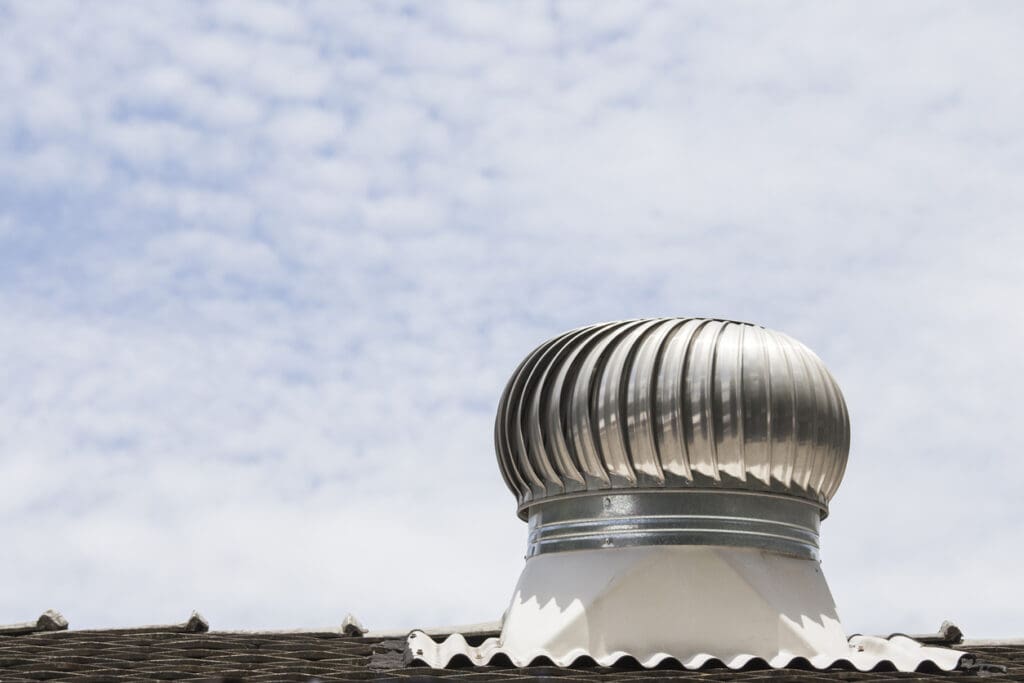
Published on November 19, 2018
When it comes to maintaining a healthy and well-ventilated home, the importance of roof ventilation cannot be overstated. Proper roof ventilation helps regulate temperature, prevents moisture buildup, and extends the lifespan of your roofing materials.
What’s the best ventilation option for your roof? Let’s explore many of the popular choices, go over their features, then you can make an informed decision on what best suits your home’s needs.
1. Ridge Vents
These vents have no moving parts and can be installed along the full length of a roof’s horizontal ridge. Ridge vents provide a continuous exhaust point for warm air and moisture.
Benefits:
- When used with soffit vents, this roofing ventilation system is highly effective in reducing moisture and hot air build-up
- Efficiently ventilates the entire attic space
- Promotes uniform airflow and maintains a consistent temperature
2. Static Vents
These non-motorized vents are strategically placed on the roof to allow hot air to escape without the need for power.
Benefits:
- A simple and cost-effective solution for promoting natural ventilation
- Available in various styles including roof louvers and turbines
3. Solar-Powered Attic Fans
Harnessing the power of the sun, these fans are designed to pull hot air out of the attic, reducing the need for electrical power.
Benefits:
- Energy-efficient
- Environmentally friendly
- Effective at preventing heat buildup in the attic space
4. Gable Vents
Placed on the gable ends of a roof, these vents allow hot air to exit and draw in cool air from the sides.
Benefits:
- Enhances cross-ventilation
- Easy to install
- Adds aesthetic appeal to the exterior of your home
5. Power Attic Fans
These are also known as power attic vents and can be installed on the roof. They have motors that use fans to get hot air and moisture out of the attic.
Some power vents have thermostats that can be triggered to turn on at certain temperatures, so it can keep heat build-up out of the attic area. These vents use electricity to run and actively draw hot air out of the attic, helping to cool the space more quickly. However, there are also models with solar panels that are built into the unit.
Benefits:
- Ideal for homes in regions with extreme temperatures
- Provides rapid ventilation
- It often comes with adjustable settings
6. Cupola Vents
Cupolas are decorative structures with built-in vents that allow hot air to escape while adding a touch of architectural charm.
Benefits:
- Combines functionality with aesthetics
- Serves as a focal point for the roof
- Enhances overall ventilation
7. Soffit Vents
Soffit vents are most commonly used to provide a way for air to be drawn in through the roof ventilation system. They are installed on the eaves of homes and are generally made of wood, aluminum, or PVC material. This venting system is most effective when used in tandem with a continuous ridge vent or other venting options.
Benefits:
- Works in tandem with other venting options
- Prevents moisture buildup
- Maintains a consistent temperature in the attic
8. Box Vents
These vents, also known as flat vents or low-profile vents, have no moving parts and are installed over a hole that is cut out of the roof. They use natural convection, creating an opening for rising hot air and moisture to be released. They are generally seen in metal or hard plastic and are most efficient when installed close to the roof ridge.
Benefits:
- Easy to install
- Low maintenance
- Ideal if you have a complex roof
9. Whirlybird Turbine Vents
Whirlybirds, or turbine vents, are wind-powered ventilation systems that spin with the breeze, actively drawing hot air and moisture out of the attic.
These vents have moving parts but no motors, relying instead on wind to power their movement. They are more effective than box vents because they will be able to move more air up and out of the attic — especially when it’s windy outside.
Benefits:
- Requires no electricity
- Cost-effective
- Works well in areas with consistent wind patterns
10. Roof Louvers
Louvered vents are designed to allow air to flow through while keeping debris and precipitation out.
Benefits:
- Protects against the elements
- It comes in various shapes and sizes
- It can be installed for both aesthetic and functional purposes
Choosing the Right Ventilation Solution
Consider Your Climate – The climate in your region can impact the effectiveness of certain vent types. Consult with a roofing professional to determine the best option for your specific climate.
Combine Ventilation Methods – Some homes benefit from a combination of different vent types to achieve optimal ventilation. Consider combining ridge vents with soffit vents or adding a solar-powered attic fan for optimal airflow.
Professional Installation – While some vents are suitable for DIY installation, others may require the expertise of a professional roofer. Ensure proper installation to maximize the benefits of your chosen ventilation system.
By understanding the various roof vent options available, you can make an informed decision to enhance the comfort and longevity of your home. Whether you opt for the simplicity of static vents or the efficiency of solar-powered fans, a well-ventilated roof is a key component of a healthy and efficient home.
Not sure if your roofing ventilation system is up to par? Our team at Warner Roofing has been helping people just like you with their roofs since 1992. Contact us today with your questions. We’re happy to provide a free, no-obligation estimate.